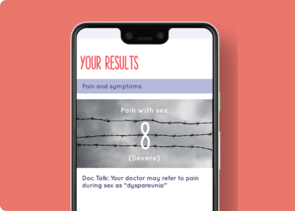Not sure how to start the conversation with your gynecologist?
This guide can help explain your pain symptoms in a way your doctor can understand.
Create your guideEndometriosis is a condition that's fueled by estrogen, a natural hormone produced by the body. So, while there's no known cure for endo, there are treatments available that may help to manage the pain.
Talk to your gynecologist about all of your treatment options. Remember to be specific about your symptoms. This can help your gynecologist find the right treatment plan for you.
Both prescription and over-the-counter painkillers can decrease inflammation and may help with endometriosis-associated pain.
Hormonal birth control can prevent estrogen fluctuation, which may reduce endometriosis-associated pain during the period. Hormonal birth control can be used in several ways. Some include:
A laparoscopy is a minimally invasive surgery that can be used to diagnose endometriosis and remove lesions, which can relieve endometriosis pain. If you are considering a laparoscopy, ask your doctor about the different methods, including:
These medications block GnRH receptors in the pituitary gland at the base of the brain. This leads to a decrease in estrogen production, so that estrogen levels in the body are lower. Lower estrogen levels can help relieve endometriosis pain.
Usually taken as an injection or nasal spray, these medications stimulate GnRH receptors in the pituitary gland at the base of the brain. Over time, this makes the receptors less sensitive, causing the body to produce less estrogen. Lower estrogen levels can help relieve endometriosis pain.
A hysterectomy is the surgical removal of the uterus (and sometimes one or both ovaries), which can relieve pain. A hysterectomy is generally viewed as a last-resort treatment because of its complexity and irreversibility.
It's important to talk to your doctor about all your treatment choices.
Learn more about a specific option that could be right for you.
In addition to prescribed treatment, many women use heating pads, and even certain

This guide can help explain your pain symptoms in a way your doctor can understand.
Create your guideReferences: 1. Fischer JR. APGO Educational Series on Women’s Health Issues. Diagnosis & management of endometriosis: pathophysiology to practice. Association of Professors of Gynecology and Obstetrics; 2012. 2. American College of Obstetricians and Gynecologists. Frequently asked questions. FAQ013. Gynecologic problems. https://www.acog.org/~/media/For%20Patients/faq013.pdf?dmc=1. Updated October 2012. Accessed February 27, 2017. 3. US Department of Health and Human Services. Endometriosis.